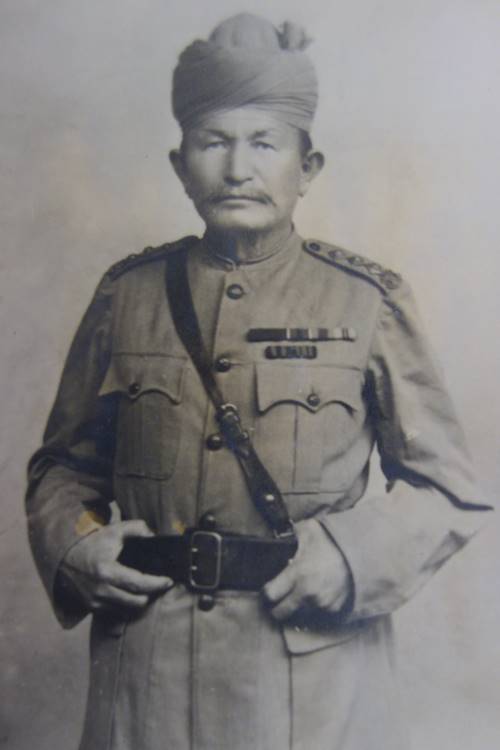This article will explain how you can use an Indian soldier’s regimental number to work out when he joined a regiment of the Indian Army. This is one of my guides to researching Indian soldiers who served in the First World War:
Indian Army Enlistment Dates
Researching a soldier who served in the ranks of the Indian Army during the First World War can be a very difficult task due to the lack of surviving documents. However, if you know a soldier’s regimental number and which regiment they served with then you’ll usually be able to estimate when they joined that regiment.
Indian infantry and cavalry regiments tended to follow a fairly logical numbering system, with each successive recruit receiving the next regimental number. Most regiments began their numbering at 1 and once they reached 5000 or so reset their numbering back to 1. The number of recruits enlisted into each regiment annually varied considerably but most saw between fifty and eighty recruits prior to the outbreak of the First World War. If you click the link below you’ll be taken to my page on enlistment dates for the Sappers and Miners where you can see clearly how the numbering follows a logical pattern:
Sappers and Miners Enlistment Dates
Why Indian Army Enlistment Dates are Important:
- Most soldiers joined the Indian Army between the ages of sixteen and twenty-two, so an approximate date of birth can be estimated.
- The location of the regiment can be found by consulting the Indian Army List, enabling you to find out where the soldier was stationed prior to October 1914.
- You can work out if a soldier was likely to have had any pre-war campaign service. The Indian Army saw extensive service on the North West Frontier and in Africa in the decades prior to war.
- A soldier with a regimental number indicating enlistment pre-1914 would most likely have embarked with his regiment during the opening stages of the war. You can then turn to the unit’s war diary to find out more.
How to Find Enlistment Dates
The easiest way to find Indian Army enlistment dates is to compare the enlistment dates of Viceroy’s Commissioned Officers who won medals for gallantry while serving in the ranks with their regimental numbers. These medals will be either the Indian Order of Merit and Indian Distinguished Service Medal. The book you will need to consult is List of Honors and Awarded to the Indian Army August 1914 to August 1921 which is available to download for free online:
Honours and Awards of the Indian Army
Once you have downloaded the book start looking at your desired regiment and cross-check the names with the Indian Army List. The Indian Army List will be your key resource as it provides enlistment dates for Viceroy’s Commissioned Officers and I have written a guide to using this valuable resource below:
Guide to Using the Indian Army List
The enlistment date recorded in the Indian Army List is when a soldier joined the Indian Army rather than the regiment. This is due to Indian regiments each having their own numbering system, so on arrival from a different regiment, the new soldier was renumbered. However, the vast majority of Indian soldiers stayed in one regiment during their service. You’ll want to try to find as many examples as possible so a clear pattern emerges. The photograph below is of Honorary Captain Dost Muhammad O.B.I. I.D.S.M. Sardar Bahadur who was Subadar-Major of the 106th Hazara Pioneers between 1904 and 1917. Captain Dost Muhammad was awarded both the Order of British India 1st Class and the Indian Distinguished Service Medal.
If you wanted to find out when Dost Muhammad enlisted into the Indian Army you would turn to the 106th Hazara Pioneers’ page in the Indian Army List. Below is Muhammad’s entry in the October 1913 Indian Army List which recorded that he enlisted on 1 August 1882 along with his promotion dates.
The Indian Army List recorded that he enlisted on 10 April 1888, so he would have been in his forties when killed. Further research would be needed to ascertain whether Subadar Negi enlisted into the Regiment on this date or was transferred later from another regiment by comparing more regimental numbers with enlistment dates. However, as the Regiment was raised as the 3rd (the Kamaon) Goorkha Regiment in 1887, it’s highly likely that Negi was one of the original recruits.
Search the CWGC Records
War diaries are also another possible source of the regimental numbers of Indian officers. A few war diaries record when senior non-commissioned officers were promoted to Jemadar. I have catalogued Indian infantry and cavalry war diaries which can be viewed by clicking on the links below and selecting the required regiment:
A Useful Tip for Enlistment Dates
A quick way to work out if your soldier was serving prior to the outbreak of the war is to search the Commonwealth War Graves Commission and view all the regiment’s casualties. Then click the box on the left-hand side which shows Relevance and click Date of Death. Look through the dates until you start to find casualties close to the regimental number of your soldier. If you find lots of casualties appearing in 1914 with regimental numbers in the vicinity of your soldier that’s a good sign that he was a pre-war regular.
However, if you can’t find any regimental numbers nearby until 1917 or 1918 and most of these casualties are sepoys rather than non-commissioned officers (see my guide to Indian Army ranks) then that’s a very good indication the soldier is a post-war enlistment. Ignore the regimental numbers of followers, cooks, sweepers etc. as they used a different numbering system.

